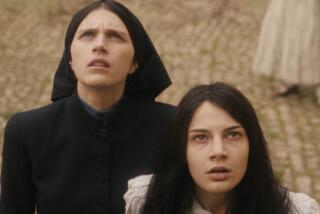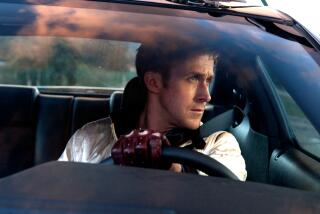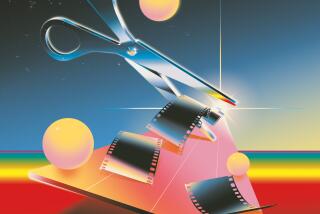From ‘Arrival’ to ‘Moonlight’ to ‘Silence,’ a look at the first frame of 9 films meant to pull you in
The first scene of a movie is often its defining moment: In subtle and large ways it lets the audience know where they are, where they’re going — and often, what to expect along the way. But deciding on that first major statement can be a challenge; sometimes, a main character dancing to “Thriller” in the bathroom mirror is the wrong choice.
Here, directors and editors from nine awards-season contenders share why they began their films as they did – and what alternate openings were abandoned along the way.
Tom Cross (editor, “La La Land”)
First scene: Amid an all-too-familiar massive L.A. freeway backup, a musical number breaks out and our hero and heroine meet cute while sparring with one another in their cars.
Revelations: “Damien [Chazelle, director] wanted to introduce our characters in a memorable way, but also their world: La La Land,” says Cross. “Our characters dream big, so it was important that the film start with a bang.”
Alternate reality? “The original plan was to open with a main title sequence that would serve as an overture. We eventually lifted out the overture and put the traffic number ahead of the intro. What was airtight on the page had been transformed through the shooting, and re-editing achieved the original spirit.”
Nat Sanders (editor, “Moonlight”)
First scene: Drug dealer Juan chats with one of his corner boys, then observes a group of boys chasing the main character, Chiron.
Revelations: “This is a low-income, African American community where crime and addiction are a normal part of life,” says Sanders. “These influences are eventually going to play a large role in the coming-of-age of Chiron. It also establishes that Juan isn’t going to be quite what you expect.”
Alternate reality? “There was a lot of discussion in the edit room about whether this was the best way to open the film,” says Sanders, who notes that one experiment had Chiron doing Michael Jackson’s “Thriller” routine in the bathroom mirror. “It was definitely charming … but tonally didn’t really belong in the film.”
Jennifer Lame (editor, “Manchester by the Sea”)
First scene: Adult brothers Lee and Joe and Joe’s young son Patrick spend the day on a fishing boat as Lee gently teases the boy.
Revelations: “It allows the audience to be introduced to Lee [Casey Affleck] the way he was before we meet him in the present,” says Lame. “On a structural level, it establishes that we will be showing past and present scenes with no obvious clues.”
Alternate reality? “The scripted beginning is various shots of the ocean and town where Lee used to live, and then Lee shoveling snow and doing handyman duties. The scene on the boat was added later once we had finally figured out the best way to make the flashbacks work in the film.”
Joe Walker (editor, “Arrival”)
First scene: A montage of the life of Hannah, the daughter of protagonist Louise (Amy Adams), which covers her birth to her death in her teenage years.
Revelations: “I find it remarkable how Amy charms us all,” says Walker. “In a bit of ad-libbed play with Hannah dressed as a sheriff, Louise creeps forward wiggling her fingers, her face alive with the fun of it. It’s a tiny symbol of the entire story: teaching to trust someone approaching with superior force.”
Alternate reality? “It was one of the earliest sequences, and yet the cut never changed throughout the year we spent making the film. The first time I showed it to [director] Denis Villeneuve, we both cried. Pretty much every other frame of the movie underwent massive upheaval, but never the opening.”
David Mackenzie (director, “Hell or High Water”)
First scene: A beat-up Camaro drives behind a sleepy West Texas town’s bank; two men emerge from the car and push an employee into the bank as she unlocks it for the day.
Revelations: “This was the first shot we did on the first day of shooting, so it was a test,” says Mackenzie. “I was able to shoot most of the outlaw element of the film sequentially. I fell in love with the process because it allows everyone to tune into the arc of the story in a far more engaged and direct way than the normal out-of-sequence shooting.”
Alternate reality? “I thought about starting with a wide-high shot of the car in the Texan landscape, but rejected it because it felt overly grandiose and slightly clichéd.”
Thelma Schoonmaker (editor, “Silence”)
First scene: Clouds rising from a hot spring reveals men in priest’s clothing being scalded alive for refusing to renounce Christianity.
Revelations: “During the editing process, we experimented with different ways to intercut Father Ferreira’s [Liam Neeson] apostasy into a scene where he tries to persuade Father Rodrigues [Andrew Garfield] into also abandoning Christianity,” says Schoonmaker. “Understanding the terrible pressures put on Ferreira as he tries to save the lives of other Christians makes one wonder if he has truly given up his faith.”
Alternate reality? The original script, by Jay Cocks and director Martin Scorsese, featured the apostasy of Ferreira in the beginning, but that was moved to later in the film. “Marty and I don’t always adhere to the script during the editing. If it is better to drop a scene, or move it to another position … we have no hesitation to do that if it will make the film work better.”
Sebastian Sepulveda (editor, “Jackie”)
First scene: A journalist is welcomed into Jackie’s home, where she has lived since leaving the White House and they discuss the interview.
Revelations: “It establishes that this interview is the present and we’re going to jump to other moments of Jackie’s life from that moment,” says Sepulveda. “Once we settle the characters and the main timeline, we can start playing with the timeline and involving the emotions of the audience.”
Alternate reality? Multiple versions for opening the film were attempted: the entrance of Jackie into the White House post-assassination; Jackie watching the documentary “Four Days in November” at her home in Hyannis Port. But “when I work in the editing room, I never look back at the script. You have to play with your footage.”
Mike Mills (screenwriter/director, “20th Century Women”)
First scene: A mother and her son stand in a supermarket parking lot and watch as her ex-husband’s and his father’s car goes up in flames.
Revelations: “It’s like a funeral for what happened to her marriage and what happened to the father’s role in the family,” says Mills. “It situates them in time – this Depression-era mother talking about ‘Casablanca’ and Louis Armstrong, talking to her punk-rock era son.”
Alternate reality? “I’m not precious about my stuff. I try other beginnings often. But I love the burning car as a way to say, ‘There’s no dad here and now the story begins.’ I love how it’s in a supermarket parking lot, where nothing bad is supposed to happen.”
John Gilroy (editor, “Rogue One”)
First scene: Imperial Director Krennick tracks former employee Galen Erso, who now lives with his wife and daughter, Jyn, on another planet. But Krennick wants the scientist back to complete the Death Star.
Revelations: “This deadly confrontation is the real key to understanding Jyn throughout the movie, whether you are clocking her ambivalence as an adult or her rekindled love and admiration for her father,” says Gilroy. “We definitely did give the beginning a ‘space western’ feel – a homesteader and his family confronted by a group of bad men on a desolate plain.”
Alternate reality? “‘Rogue’ was always trying to push the boundaries of what a ‘Star Wars’ movie could be. That was intentional. We engineered our opening so that an informational, back-story crawl was not important or needed.”
More to Read
From the Oscars to the Emmys.
Get the Envelope newsletter for exclusive awards season coverage, behind-the-scenes stories from the Envelope podcast and columnist Glenn Whipp’s must-read analysis.
You may occasionally receive promotional content from the Los Angeles Times.






